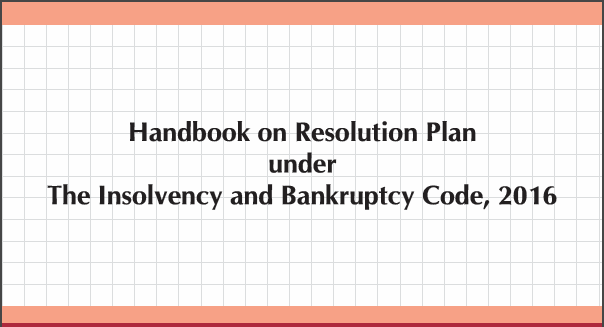Handbook on Resolution Plan under The Insolvency and Bankruptcy Code, 2016: ICAI
- Chapter 1 Introduction
- Time is the essence
- Chapter 2 Resolution Plan under the Code
- Objective:
- The Road to Resolution of Financial Service Providers under IBC
- Resolution Plan: approvals and deemed no objection
- Chapter 3 Information Memorandum
- Purpose
- Time and manner of Submission of Information Memorandum
- Read & Download the full Copy in pdf:
Chapter 1 Introduction
Corporate Finance is based on funding from equity and debt. As long as debt obligations are met, equity owners have complete control, and creditors have no say in how the business is run. When default takes place, control is supposed to transfer to the creditors, equity owners should have no say. But in India, for many decades, creditors had low power when faced with default. Promoters stayed in control of the company even after default. Under these conditions, the recovery rates obtained in India remained very low.
When creditors know that they have weak rights resulting in a low recovery rate, they are averse to lend. Hence, lending in India has been concentrated in a few large companies that have a low probability of failure. Further, secured credit dominates, as the creditor’s rights are partially present only in this case. Lenders have an emphasis on secured credit. In this case, credit analysis is relatively easy. It only requires taking a view on the market value of the collateral. As a consequence, credit analysis as a sophisticated analysis of the business prospects of a firm has shrivelled and unsecured lending remained unchartered territory as a form of lending.
Related Topic:
The Provincial Insolvency Act, 1920
To address this problem, among others, The Insolvency and Bankruptcy Code, 2016 (hereinafter referred to as “Code”) was enacted. The objective of the Code is to consolidate and amend the laws relating to reorganization and insolvency resolution of corporate persons, partnership firms, and individuals in a time-bound manner for maximization of value of assets of such persons, to promote entrepreneurship, availability of credit, and balance the interests of all the stakeholders including alteration in the priority of payment of government dues and to establish an Insolvency and Bankruptcy Board of India and matters connected therewith or incidental thereto. An effective legal framework for the timely resolution of insolvency and bankruptcy would support the development of credit markets and encourage entrepreneurship. It would also improve the Ease of Doing Business, and facilitate more investments leading to higher economic growth and development.
Related Topic:
Information Utility & lodgment of Default under IBC, 2016
After detailed deliberation by the Bankruptcy Law Reforms Committee (“BLRC”) on the number and capability of operational creditors of most of the Corporate Debtors in India, in the Insolvency and Bankruptcy Code, it is envisaged that there is only one correct forum for evaluating such possibilities is that the decision making is given to a Committee of Creditors (hereinafter referred to as “CoC”), where all financial creditors have votes in proportion to the magnitude of debt that they hold.
There may be many situations in which a viable mechanism can be found through which the Corporate Debtor is protected as a going concern. To the extent that this can be done, the costs imposed upon society go down, as liquidation involves the destruction of the organizational capital of the Corporate Debtor.
Related Topic:
Handbook on Corporate Insolvency Resolution Process under The Insolvency and Bankruptcy Code, 2016: ICAI
The solution structured in the Code is when default takes place a Corporate Insolvency Resolution Process (CIRP) can be initiated and run for as long as 180 days. The IRP/RP (IP) is to oversee the Corporate debtor who is given substantial powers. While the CIRP is in process, the law enshrines a calm period which gives a better chance for the firm to survive as a going concern and assures creditors and Corporate Debtor that assets are protected while they negotiate. For the 180 days for which the CIRP is in operation, the CoC analyses the company hears revival proposals, and makes up its mind about what must be done. When 66% of the CoC members agree on a revival plan, this plan would be binding on all the remaining stakeholders including employees, workmen, operational creditors, State/Central Governments, and shareholders. In limited circumstances, if 66 % of the CoC decides that the complexity of a case requires more time for a resolution plan to be finalized, a one-time extension on expiry of the 180 days period, for up to 90 days is possible with the prior approval of the Adjudicating Authority.
Related Topic:
The Provincial Insolvency Act, 1920
Time is the essence
In the recent Hon’ble Supreme Court Judgement, it is held that “Time Is The Essence Of The Corporate Insolvency Resolution Process”: The instant judgment required the Hon’ble Supreme Court to balance two conflicting ideas that arise in insolvency proceedings. It is a well-recognized principle that the liquidation of the corporate debtor is the last resort. The Hon’ble Supreme Court held that the primary focus of the IBC is to ensure the revival and continuation of the corporate debtor by protecting it from a corporate death by liquidation. Therefore, the IBC is envisaged as beneficial legislation that puts the corporate debtor back on its feet and not mere recovery legislation for creditors.
To rescue the Corporate Debtor, external bids are invited from resolution applicants interested in submitting resolution/revival plans. A resolution plan can propose multiple approaches for resolving the debtor, including debt restructuring and reorganization of its affairs and capital structure. The CoC then votes to accept or reject plans. As the revival of Corporate Debtors is required to have support from operational creditors as well, the BLRC also recommends that a resolution plan must necessarily provide for certain protections for operational creditors. A plan approved by the committee must be eventually approved by the Adjudicating Authority for it to be binding on all affected stakeholders. The entire process must be completed within strict timelines, failing which the debtor is to be liquidated. This (automatic liquidation upon failure to complete the process within stipulated timelines) is one of the most unique features of the Code.
Related Topic:
Guide to CA Certificates in GST: ICAI
Chapter 2 Resolution Plan under the Code
Objective:
The objective of the Resolution Plan is to get a proposal from a Resolution Applicant that aims to provide a resolution to the problem of the corporate debtor’s insolvency and its consequent inability to pay off debts. The objectives of the Resolution Plan under the Code with the order of its priority is:
1. The first objective is “resolution”.
2. The second objective is “maximization of value of assets of the ‘Corporate Debtor” and
3. the third objective is “promoting entrepreneurship, availability of credit and balancing the interests of all stakeholders”.
Section 5(26) of IBC, 2016 – “Resolution plan” means a plan proposed by resolution applicant for insolvency resolution of the corporate debtor as a going concern in accordance with Part II; it has been further clarified by the explanation that resolution plan may include provisions for restructuring of the Corporate debtor including by way of merger, amalgamation and demerger.
Related Topic:
(VAT) GST Vs IBC : Tale of two judgments
In order to understand it more clearly it has to be further stated that:
a) Resolution is not a sale, but the resolution of the corporate debtor as a going concern.
• Resolution is not an auction, feasibility and viability of a resolution plan are not amenable to bidding or auction. It requires application of mind by financial creditors who understand the business well;
• Resolution is not recovery. While recovery bleeds the corporate debtor to death, resolution endeavours to keep the corporate debtor alive. IBC prohibits and discourages recovery in several ways;
• Resolution is not liquidation. Liquidation is inequitable as it considers the claims of a set of stakeholders only if there is any surplus after satisfying the claims of a prior set of stakeholders fully. IBC, therefore, does not allow liquidation of a corporate debtor directly.
b) The Resolution plan enhances the economic value as under:
• Resolution Plan is a proposal by the Resolution Applicant, providing Revival Plan to ensure continuity of business along with the most effective use of assets and equipment. The proposal takes into consideration the production facility and infrastructure which can be put to optimum economic use.
• The plan provides for the continuance of workers and employees in the employment, and additional employment to be generated by employing an additional workforce.
• The plan provides to explore the company’s history of the business and goodwill to its full extent.
• The resolution applicant provides to infuse required funds for debt restructuring and capital restructuring working capital requirement and refurbishing of the plant and machineries. The objective of debt restructuring is to satisfy the secured lenders through settlement terms and release the securities.
• The Resolution applicant provides to take over the management of the company by inducting professional, experienced, successful promoter directors and independent directors for the success of the Resolution plan. The resolution applicant enjoys full freedom of management of the company.
• The resolution applicant is required to abide by its commitment to infuse the fund’s requirement for the initial payment and subsequent installment in a timely manner.
• The Resolution applicant normally has adequate resources to induct additional capital as it will be required in the future with the consent of the new board of directors and its shareholders.
• The resolution Applicant may acquire the business of the Corporate debtor and merge with its existing business to create inorganic growth to use a scale of operations.
Regulation 37 of Corporate Insolvency Resolution Process (hereinafter referred to as CIRP) issued by IBBI provides for various tools to structure the Resolution plan by means of the following measures:
a. transfer of all or part of the assets of the corporate debtor to one or more persons;
b. sale of all or part of the assets whether subject to any security interest or not;
ba. restructuring of the corporate debtor, by way of merger, amalgamation, and demerger;
c. the substantial acquisition of shares of the corporate debtor, or the merger or consolidation of the corporate debtor with one or more persons;
ca. cancellation or delisting of any shares of the corporate debtor, if applicable;
d. satisfaction or modification of any security interest;
e. curing or waiving of any breach of the terms of any debt due from the corporate debtor;
f. reduction in the amount payable to the creditors;
g. extension of a maturity date or a change in the interest rate or other terms of a debt due from the corporate debtor;
h. amendment of the constitutional documents of the corporate debtor;
i. issuance of securities of the corporate debtor, for cash, property, securities, or in exchange for claims or interests, or other appropriate purposes;
j. change in portfolio of goods or services produced or rendered by the corporate debtor;
k. change in technology used by the corporate debtor; and
l. obtaining necessary approvals from the Central and State Governments and other authorities.
The Road to Resolution of Financial Service Providers under IBC
Insolvency and Bankruptcy Code, 2016 (“IBC”) applies to corporate debtors other than financial services providers (“FSPs”). However, in terms of Section 227 of the IBC, the Central Government is empowered to notify, in consultation with the relevant financial sector regulators, either FSPs or which categories of FSPs should be included for the purpose of their insolvency and liquidation proceedings under the terms of the IBC. The Insolvency and Bankruptcy (Insolvency and Liquidation Proceedings of Financial Service Providers and Application to Adjudicating Authority Rules), 2019 (“FSP Rules”) issued under Section 227 of the IBC were notified in the official gazette by the Ministry of Corporate Affairs on November 15, 2019, and came into effect the same day. The FSP Rules extend the applicability of the IBC to such FSPs, with certain modifications as specified by way of the FSP Rules. FSPs will therefore be resolved through a combination of the IBC principles and processes and the distinct processes set out in the FSP Rules.
Resolution Plan: approvals and deemed no objection
In addition to compliances with all other provisions applicable to resolution plans under the IBC, the FSP Rules provide that a resolution plan submitted for an FSP must specifically include a statement about how it satisfies or intends to satisfy the requirements of engaging in the business of the financial service provider in accordance with applicable laws.
Reinforcing the centrality of the Committee of Creditors, their approval is required for the resolution plan. Following such approval, the appropriate regulator is also required to provide a no-objection certificate. This no objection certificate is required to be provided by the Appropriate Regulator on the basis of ‘fit and proper criteria applicable to the business of the FSP, without prejudice to the applicability of the eligibility criteria prescribed under Section 29A of the IBC. Given that the resolution of financial firms must be undertaken swiftly, a concept of “deemed” no-objection has been built in the following 45 working days from the submission of the application to the appropriate regulator. In this regard, the Rules also provide for the constitution of an Advisory Committee which advises the Administrator in the operations of the FSP during the corporate insolvency resolution process.
The timelines for resolution appear to be aligned with the IBC i.e. a directory period of 330 days.
The resolution plan once approved by the NCLT will be binding on creditors, members, and other stakeholders as set out in Section 31 (1) of the IBC.
Chapter 3 Information Memorandum
Purpose
The primary purpose of an Information Memorandum is to provide information to the members of CoC and Resolution Applicant with basic information of the Corporate Debtor for informed decision during CIRP and the Resolution Applicant to make an informed decision for submitting Resolution Plan.
Information Memorandum is a comprehensive description of all the business and the fundraising proposal. It is intended to provide all the information needed by an investor to make a fully informed decision in a positive and appealing manner. It is something that represents a resume of the corporate debtor which is seeking investment from the prospective investor.
In the CIRP, Information Memorandum is a basis document which contains all the aspect of the Corporate Debtor that will enable the Resolution Applicant to prepare resolution Plan.
An information memorandum is defined as – “information memorandum” means a memorandum prepared by the resolution professional under sub-section (1) of section 29.
Time and manner of Submission of Information Memorandum
It is one of the duties of the Resolution Professional under section 25 (g) to prepare the information Memorandum in accordance with the provisions of section 29. Section 29 provides that the resolution professional shall prepare an information memorandum in such form and manner containing such relevant information as may be specified by the Board (i.e. IBBI) for formulating a resolution plan. The Board has prescribed in Regulation 36 the form and way Information is to be prepared and circulated amongst CoC members and Resolution Applicant. Regulation 36 provides that subject to sub-regulation (4), the resolution professional shall submit the information memorandum in the electronic form to each member of the committee within two weeks of his appointment, but not later than the fifty-fourth day from the insolvency commencement date, whichever is earlier.
Read & Download the full Copy in pdf:
If you already have a premium membership, Sign In.
 ConsultEase Administrator
ConsultEase Administrator
Consultant
Faridabad, India
As a Consultease Administrator, I'm responsible for the smooth administration of our portal. Reach out to me in case you need help.













